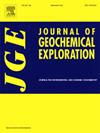Vectoring towards buried high-purity quartz metapegmatites using low-elevation radiometric and soil geochemical surveying: Method validation in Tysfjord, Norway
IF 3.4
2区 地球科学
Q1 GEOCHEMISTRY & GEOPHYSICS
引用次数: 0
Abstract
Group 2/NYF pegmatites may be economically enriched in rare minerals. In this study we report testing of two exploration methods, gamma ray surveying and soil geochemical mapping, undertaken within the GREENPEG project. Palaeoproterozoic metapegmatites in the Tysfjord area, Nordland, Norway, include some which have been mined for pure quartz. Geologically, the ore zones are the quartz cores of metapegmatites whose other zones and metasomatic halos are enriched in U, Th, REE, Nb and other rare elements. The Jennyhaugen metapegmatite was the main test site because its subcrop beneath 0.1–1.0 m soil can be traced from an open pit mine, and aerial surveying is unobstructed by trees. Helicopter-borne radiometry at 60 m altitude and drone-borne radiometry at 25–35 m altitude detect the metapegmatite, while walking (1.0 or 1.6 m height) and 15 m altitude drone-borne radiometry resolve the metapegmatite and metasomatic halo subcrop in detail. Total gamma ray count measurements provide as good an exploration tool as Th or U radiation; K radiation does not show useful anomalies. Both A- and C-horizon soil geochemical mapping also reveal U, Th, Nb and other geochemical anomalies above metapegmatite and halo subcrop. A-horizon soil samples appear to more accurately locate these targets, perhaps because they effectively sample larger surface areas of subcropping rock, whose grain size is very coarse (typically metre scale) within the metapegmatite. C-horizon samples collected from the soil-rock interface are less likely to be representative of the metapegmatite. Gamma ray surveying is recommended rather than soil chemical mapping for exploration, by helicopter at district scale and by drone or walking at prospect scale. It is quicker, requires less field workers, has higher resolution and is less expensive than soil geochemical mapping. Soil chemistry may be preferred for prospect-scale exploration, however, where the commodity sought does not spatially correlate with U and/or Th concentrations.

利用低海拔辐射测量和土壤地球化学测量对埋藏的高纯度石英偏晶岩进行矢量化:在挪威Tysfjord的方法验证
2组/NYF伟晶岩可能具有经济富集的稀有矿物。在这项研究中,我们报告了两种勘探方法的测试,伽马射线测量和土壤地球化学测绘,在GREENPEG项目中进行。在挪威北部的提斯峡湾地区,古元古代的变质岩中有一些是为纯石英开采的。地质上,矿带为偏晶岩石英芯,其他矿带和交代晕富集U、Th、REE、Nb等稀有元素。Jennyhaugen变长岩是主要的试验场,因为它在0.1-1.0 m土壤下的亚作物可以从露天矿井中追踪到,而且航空测量不受树木的阻碍。60 m高度的直升机载辐射测量和25-35 m高度的无人机载辐射测量检测偏伟岩,而行走(1.0或1.6 m高度)和15 m高度的无人机载辐射测量详细解析偏伟岩和交代晕亚群。总伽马射线计数测量提供了与Th或U辐射一样好的勘探工具;K辐射没有显示有用的异常。A层和c层土壤地球化学填图还发现了偏长岩和晕状亚层上方的U、Th、Nb等地球化学异常。a层土壤样本似乎更准确地定位了这些目标,也许是因为它们有效地取样了更大的地下岩石表面,这些岩石在偏长岩中颗粒尺寸非常粗(通常为米级)。从土壤-岩石界面采集的c层样品不太可能代表偏长岩。建议使用伽马射线测量而不是土壤化学测绘进行勘探,在地区尺度上使用直升机,在远景尺度上使用无人机或步行。与土壤地球化学制图相比,它速度更快,需要较少的现场工作人员,分辨率更高,成本更低。然而,在寻找的商品与U和/或Th浓度在空间上不相关的情况下,土壤化学可能是勘探规模勘探的首选方法。
本文章由计算机程序翻译,如有差异,请以英文原文为准。
求助全文
约1分钟内获得全文
求助全文
来源期刊

Journal of Geochemical Exploration
地学-地球化学与地球物理
CiteScore
7.40
自引率
7.70%
发文量
148
审稿时长
8.1 months
期刊介绍:
Journal of Geochemical Exploration is mostly dedicated to publication of original studies in exploration and environmental geochemistry and related topics.
Contributions considered of prevalent interest for the journal include researches based on the application of innovative methods to:
define the genesis and the evolution of mineral deposits including transfer of elements in large-scale mineralized areas.
analyze complex systems at the boundaries between bio-geochemistry, metal transport and mineral accumulation.
evaluate effects of historical mining activities on the surface environment.
trace pollutant sources and define their fate and transport models in the near-surface and surface environments involving solid, fluid and aerial matrices.
assess and quantify natural and technogenic radioactivity in the environment.
determine geochemical anomalies and set baseline reference values using compositional data analysis, multivariate statistics and geo-spatial analysis.
assess the impacts of anthropogenic contamination on ecosystems and human health at local and regional scale to prioritize and classify risks through deterministic and stochastic approaches.
Papers dedicated to the presentation of newly developed methods in analytical geochemistry to be applied in the field or in laboratory are also within the topics of interest for the journal.
 求助内容:
求助内容: 应助结果提醒方式:
应助结果提醒方式:


